Expanding #Plume from #DART's #Impact
#Astronomy #Picture of the Day
https://apod.nasa.gov/apod/ap221005.html
https://www.youtube.com/shorts/MC8f6gxqn3s
3 Likes
1 Comments
https://apod.nasa.gov/apod/ap221005.html
https://www.youtube.com/shorts/MC8f6gxqn3s
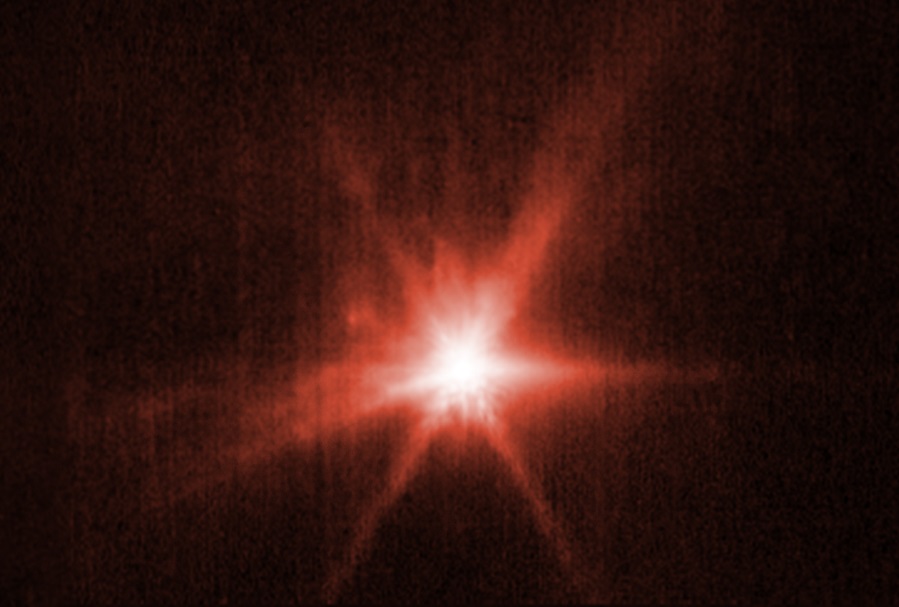
На новом изображении, полученном с помощью камеры ближнего инфракрасного диапазона (NIRCam) космического телескопа Джеймс Уэбб, виден Диморфос, астероид-спутник в системе двойного астероида Дидимос, примерно через 4 часа после того, как зонд DART врезался в Диморфос. На изображении видны плотное, компактное ядро и шлейфы материала, которые выглядят как струйки, растекающиеся от центра места удара. Острые лучи […]
Сообщение Телескопы Джеймс Уэбб и Хаббл провели наблюдения за астероидом Диморфос появились сначала на AB-NEWS - Новости науки и техники.
#астрономия #космонавтика #dart #астероиды #джеймсуэбб #наса #хаббл #lang_ru #ru #abnewsru #abnews #наукаитехника

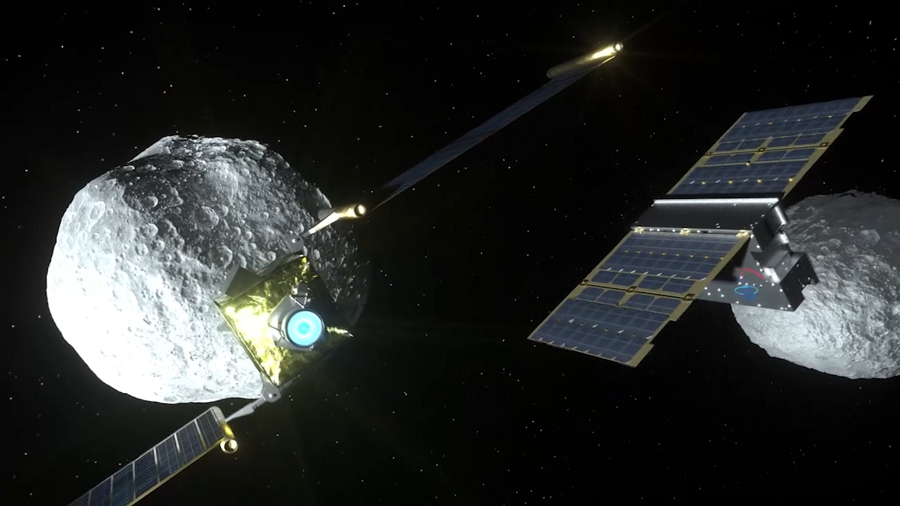
Десятки наземных телескопов были направлены на астероид Диморфос, с которым вчера столкнулся космический зонд DART, но не только они наблюдали за столкновением. Ближайший спутник CubeSat, развернутый специально для фотографирования события с близкого расстояния, теперь передал свои изображения исторической встречи, демонстрируя столкновение и образовавшиеся обломки во всей космической красе. Небольшой космический аппарат -- Light Italian CubeSat […]
Сообщение LICIACube передает фотографии столкновения зонда DART с астероидом появились сначала на AB-NEWS - Новости науки и техники.
#астрономия #космонавтика #dart #esa #астероиды #lang_ru #ru #abnewsru #abnews #наукаитехника
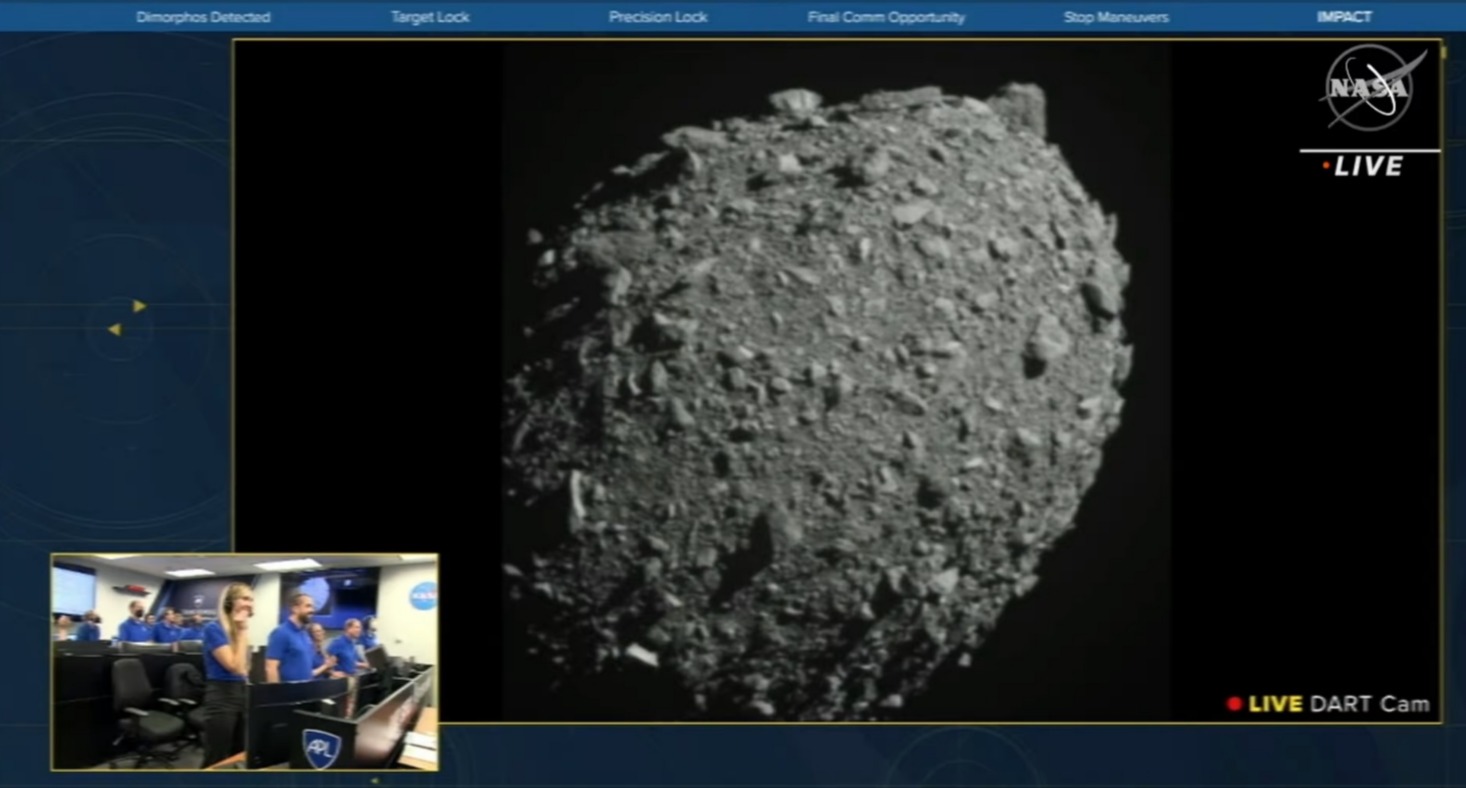
Миссия планетарной защиты сегодня достигла исторического апогея, когда зонд НАСА эффектно врезался в астероид Диморфос, уничтожив себя в процессе столкновения. Первая в мире попытка отклонить от курса астероид была признана успешной и считается важной практикой того, как можно будет отклонить опасный астероид в будущем. Миссия DART (Double Asteroid Redirection Test) — это попытка изменить орбиту […]
Сообщение Зонд DART врезался в астероид в ходе исторического испытания (видео) появились сначала на AB-NEWS - Новости науки и техники.
#астрономия #космонавтика #dart #esa #астероиды #наса #lang_ru #ru #abnewsru #abnews #наукаитехника
Die US-Raumfahrtbehörde hat ein spektakuläres Experiment durchgeführt: Erstmals raste eine Sonde absichtlich in einen Asteroiden, um dessen Flugbahn zu verändern.#NASA #Asteroid #Dart #Dimorphos #Didymos #Raumfahrt #Weltraum #Experiment #Aufprall
NASA-Sonde kracht in Asteroiden | DW | 27.09.2022
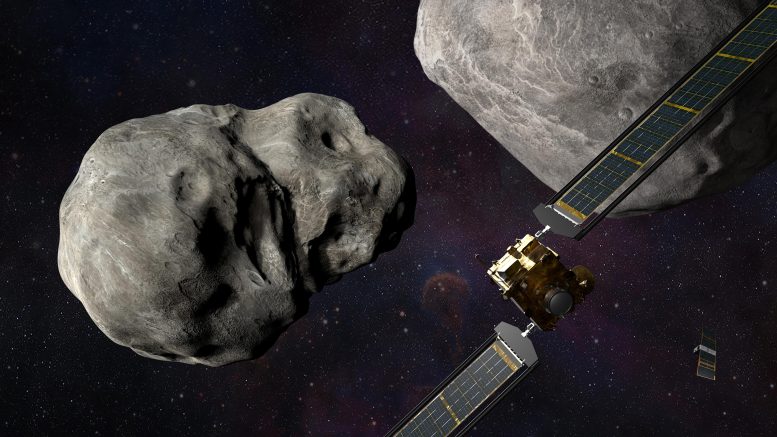
Космический аппарат НАСА DART (Double Asteroid Redirection Test) должен врезаться в астероид в понедельник, 26 сентября, в ходе первого в истории испытания способности человечества отклонять опасные для планеты космические камни до того, как они столкнутся с Землей. DART массой 550 кг, приземистый зонд кубической формы, состоящий из датчиков, антенны, ионного двигателя и двух солнечных батарей […]
Сообщение Космический зонд DART готовится врезаться в астероид Диморфос и изменить его орбиту появились сначала на AB-NEWS - Новости науки и техники.
#астрономия #космонавтика #dart #esa #астероиды #наса #lang_ru #ru #abnewsru #abnews #наукаитехника
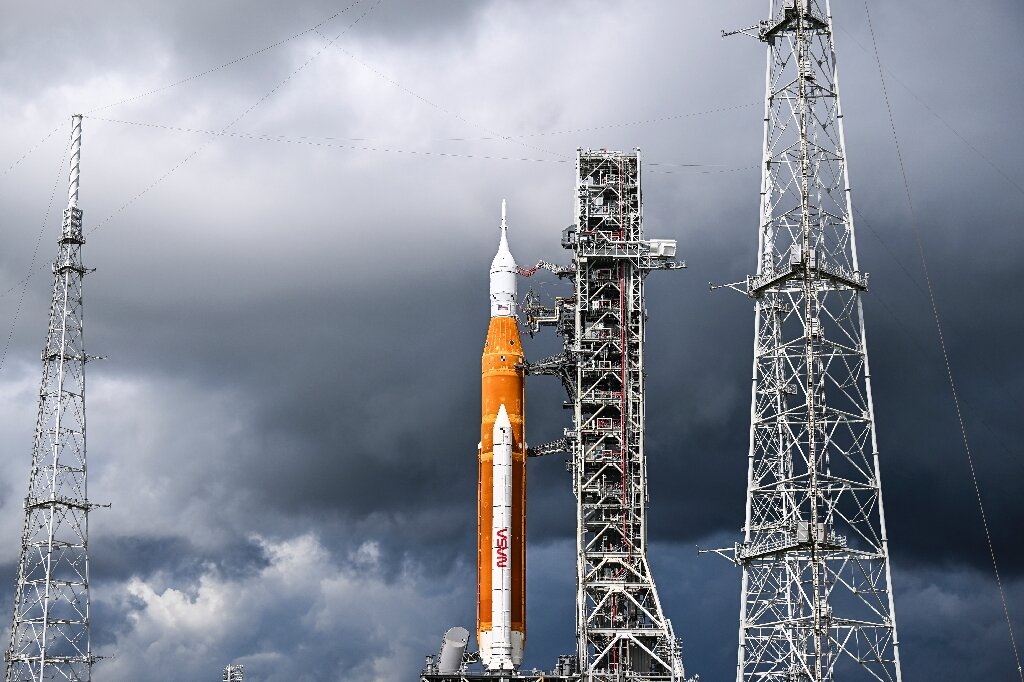
НАСА рассматривает 23 и 27 сентября в качестве возможных дат для своей следующей попытки запуска своей миссии Artemis 1 к Луне, сообщил журналистам высокопоставленный чиновник агентства Джим Фри в четверг. Две предыдущие попытки были отменены после того, как гигантская ракета SLS столкнулась с техническими сбоями, включая утечку топлива. Окно запуска 23-го откроется в 6:47 (10:47 […]
Сообщение НАСА рассматривает еще две даты в сентябре для возможного запуска Artemis 1 появились сначала на AB-NEWS - Новости науки и техники.
#космонавтика #artemis #dart #sls #водород #наса #lang_ru #ru #abnewsru #abnews #наукаитехника

Камера Didymos Reconnaissance and Asteroid Camera для оптической навигации (DRACO) на борту космического аппарата DART сделала новые изображения двойной системы околоземного астероида Didymos, состоящего из 780-метрового Дидимоса и меньшего, приблизительно 160-метрового спутника Диморфос. 26 сентября 2022 года DART повлияет на Диморфос, чтобы изменить его орбиту. «Этот первый набор изображений используется в качестве теста для проверки […]
Сообщение Космический аппарат DART впервые увидел двойной астероид Дидимос появились сначала на AB-NEWS - Новости науки и техники.
#астрономия #космонавтика #dart #астероиды #lang_ru #ru #abnewsru #abnews #наукаитехника

НАСА проводит первое в мире комплексное испытание планетарной защиты от потенциальных столкновений с астероидами в рамках проекта Double Asteroid Redirection Test (DART). Исследователи из Бернского университета и Национального центра научных исследований (NCCR) PlanetS теперь показали, что удар космического зонда DART по его цели может сделать астероид почти неузнаваемым, а не оставить после себя относительно небольшой […]
Сообщение Исследование показало, что космический аппарат DART может уничтожать астероиды появились сначала на AB-NEWS - Новости науки и техники.
#астрономия #космонавтика #dart #esa #астероиды #наса #lang_ru #ru #abnewsru #abnews #наукаитехника
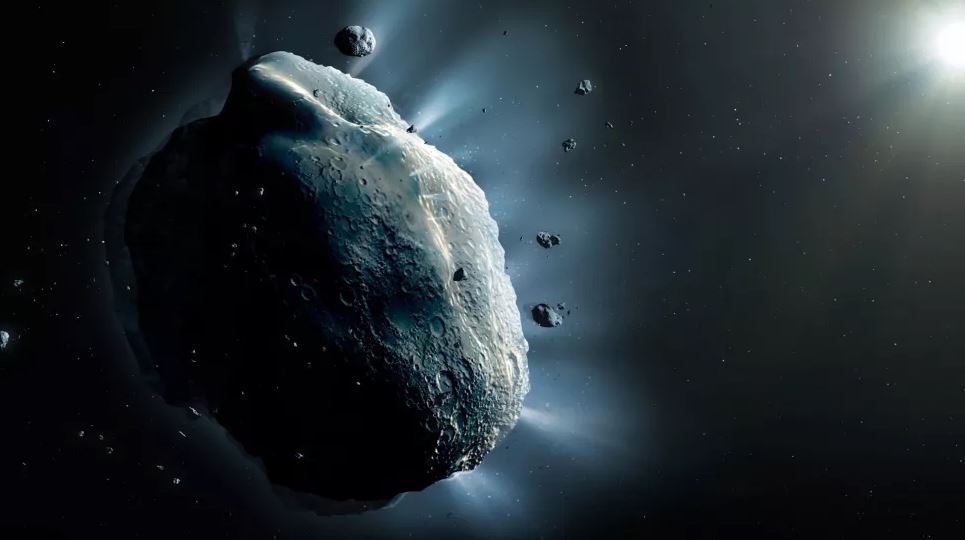
По данным Центра изучения объектов, сближающихся с Землей (CNEOS) НАСА, 27 мая к Земле приблизится огромный астероид. Однако бояться не стоит: астероид, названный 7335 (1989 JA), пролетит мимо нашей планеты на расстоянии примерно в 4 миллиона километров — или почти в 10 раз больше среднего расстояния между Землей и Луной. Тем не менее, учитывая большие […]
Сообщение Огромный астероид диаметром 1,8 км приблизится к Земле 27 мая появились сначала на AB-NEWS - Новости науки и техники.
#астрономия #астрофизика #исследованиекосмоса #новостинаукиитехники #dart #астероиды #наса #lang_ru #ru #abnewsru #abnews #наукаитехника
![]()
Финансируемая НАСА Система последнего оповещения о столкновении с землей астероида (ATLAS) -- современная система обнаружения астероидов, управляемая Институтом астрономии Гавайского университета, достигла новой вехи, став первым обзором, способным каждые 24 часа исследовать все темное небо в поисках околоземных объектов (NEO), которые могут представлять опасность столкновения с Землей в будущем. В настоящее время ATLAS, состоящий из […]
Сообщение Система слежения за астероидами теперь способна выполнять поиск по всему небу появились сначала на AB-NEWS - Новости науки и техники.
#астрономия #исследованиекосмоса #dart #астероиды #наса #lang_ru #ru #abnewsru #abnews #наукаитехника
I’ve released my first Dart/Flutter library. It implements the Result Monad (like in Rust) for doing result/error propagation/handling without relying on exceptions or returning null or specific values for errors. #dart #dartlang #flutter #flutterdev nequalsonelifestyle.com/2021/11/29/res…
Sobre a nova missão espacial #DART -
Separação de naves espaciais! #DARTmission 🛰 -
Obrigado pela ótima viagem #SpaceX #Falcon9 - 🚀 -
A equipe da espaçonave estará monitorando para Aquisição de Sinal
https://pic.twitter.com/6px23JnNuS -
RT NASA’s Launch Services Program -

Сегодня успешно стартовала миссия по изменению орбиты астероида — Double Asteroid Redirection Test (DART). Запуск DART был осуществлен сегодня, 24 ноября, в 09:21 мск, на борту ракеты SpaceX Falcon 9 с космической базы Ванденберг в Калифорнии. После отделения от ракеты-носителя и более года полета миссия перехватит астероид Дидимос (в переводе с греческого «Близнец») в конце сентября 2022 года, […]
Сообщение Стартовала миссия DART -- космический зонд впервые изменит орбиту астероида появились сначала на AB-NEWS - Новости науки и техники.
#астрономия #исследованиекосмоса #космонавтика #dart #астероид #наса #lang_ru #ru #abnewsru #abnews #наукаитехника
 SpaceX’s Falcon 9 rocket fires up to launch NASA’s DART asteroid probe from Vandenberg Space Force Station in California. (NASA via YouTube).
SpaceX’s Falcon 9 rocket fires up to launch NASA’s DART asteroid probe from Vandenberg Space Force Station in California. (NASA via YouTube).
A space probe the size of a school bus is on its way to smash into an asteroid the size of Egypt’s Great Pyramid, directed by thruster systems built by Aerojet Rocketdyne in Redmond, Wash.
This is no “Armageddon,” and there’s no need for Bruce Willis to ride to the rescue. But the experiment is expected to help scientists figure out how to divert a dangerous asteroid heading for Earth should the need arise. That’s one giant leap for planetary defense — and for Aerojet Rocketdyne, whose made-in-Redmond thrusters have been used on dozens of space missions.
“We’ve been to every planet in the solar system,” said Joseph Cassady, Aerojet’s executive director for space. “But this is the first time we’ve ever done something that’s really truly planned as a defense against threats to life on Earth. The test we’re going to do here is really the first step in getting ourselves ready as a species to react and respond if we ever are threatened in that way.”
NASA’s Double Asteroid Redirection Test mission, or DART, got off to a showy start with tonight’s launch of a SpaceX Falcon 9 rocket from Vandenberg Space Force Base in California. Liftoff occurred at 10:21 p.m. PT, at the end of a smooth countdown.
Minutes after launch, the rocket’s second stage separated from the first-stage booster and proceeded to orbit, while the booster flew itself back to an at-sea landing on a drone ship stationed in the Pacific. Within an hour after launch, the second stage was due to deploy the DART spacecraft and send it on its way.
Tonight’s launch marked the first leg of a 10-month journey to a double-asteroid system that’ll be nearly 7 million miles away from Earth at the time of the encounter. The larger asteroid, called Didymos, is about half a mile wide — but that’s not DART’s target. Instead, Aerojet’s thrusters will guide the spacecraft to hit the smaller asteroid, known as Dimorphos.
Dimorphos, which is about 525 feet wide, orbits Didymos like our moon orbits Earth. In fact, the asteroid was nicknamed “Didymoon” before it was given its official name last year. Dimorphos makes a complete circuit in 11.9 hours, and if everything goes just right, researchers expect the kinetic effect of DART’s collision to shorten that orbital period by as much as several minutes.
There’s no chance that Dimorphos will break up, veer out of orbit or head in Earth’s direction — which is what typically happens in movies like “Armageddon” (starring Bruce Willis) or “Don’t Look Up” (premiering next month on Netflix).
“We picked it for the reason that it’s perfectly safe,” Cassady said. “Even if we miss, or we don’t accomplish the mission that we thought we would, there’s never going to be a danger to Earth. And if we hit it too hard, there still won’t be a danger to Earth.”
Mission controllers at Johns Hopkins University’s Applied Physics Laboratory have programmed the probe to control Aerojet’s onboard thruster systems autonomously, so that it hits Dimorphos cleanly at a velocity of about 15,000 mph.
A shoebox-sized, Italian-built piggyback probe — known as the Light Italian CubeSat for Imaging Asteroids, or LICIACube — will be deployed from the main spacecraft 10 days before the encounter and hang back to capture images of the smash-up from a safe distance. Meanwhile, DART will be sending back images of Dimorphos all the way up to the moment of impact.
Based on NASA’s experience with a comet-smashing mission in 2005 called Deep Impact, DART’s destruction should be a real blast. In fact, it could take years for the dust to settle. In order to get a clear picture of the collision’s aftermath, the European Space Agency is planning to launch a reconnaissance probe to the double-asteroid system in 2024.
Dimorphos is far smaller than the mega-asteroid that wiped out the dinosaurs 66 million years ago. But it’s far bigger than the 65-foot-wide asteroid that broke up spectacularly over Siberia in 2013 and turned a brighter spotlight on the potential threat from asteroids and comets. An asteroid the size of Dimorphos could wipe out a city if it hit in just the wrong place.
For that reason, scientists will closely analyze the findings from the DART mission and factoring them into their calculations for changing the path of a threatening asteroid — perhaps with a kinetic impactor like DART, or a “gravity tractor” that could make a subtler course correction, or a nuclear blast if time is short.
“It’s good to be prepared,” Cassady said.
Engineers at Aerojet Rocketdyne will closely analyze DART’s performance as well, and not just because of the planet protection angle. The $330 million mission also marks the first in-space use of the NEXT-C electric propulsion system, which was developed by Aerojet’s Redmond team in collaboration with NASA’s Glenn Research Center and Ohio-based ZIN Technologies.
NEXT-C, which features a super-efficient, low-thrust xenon ion engine, will supplement Aerojet’s more traditional, hydrazine-fueled MK-103G thruster system. “On DART, we’re getting a good test,” Cassady said.
Cassady said NEXT-C would be well-suited for deep-space missions aimed at bringing back pieces of a comet or an asteroid — perhaps in the next phase of NASA’s campaign to develop a planetary defense system.
“It’s a good fit because DART could use us,” he said. “It’s not as stressful of a mission as a comet sample return mission would be. But it’s a good proof that the engine can do the things we’ve said it will do in space, and we’ll wring everything out. It’s almost like our shakedown cruise, and then we’ll have it ready for that next mission.”
Check out these images of tonight’s launch:
time to redirect some asteroids!????
3 minute long exposure view of a
[
@spacex
](https://twitter.com/SpaceX?ref_src=twsrc%5Etfw)
falcon 9 launching the DART mission tonight for NASA????????
????for
[
@arstechnica
](https://twitter.com/arstechnica?ref_src=twsrc%5Etfw)
settings⚙️/downloads⬇️/prints???? of this photo:
[
[
pic.twitter.com/SzFGYPQX40
— Trevor Mahlmann (@TrevorMahlmann)
[
November 24, 2021
](https://twitter.com/TrevorMahlmann/status/1463397931134767106?ref_src=twsrc%5Etfw)
Liftoff! The
[
@spacex
](https://twitter.com/SpaceX?ref_src=twsrc%5Etfw)
Falcon9 rocket carrying
[
@NASA
](https://twitter.com/NASA?ref_src=twsrc%5Etfw)
DART spacecraft launches from Vandenberg Space Force base in California. I had this phenomenal view from my backyard in Santa Maria, CA.
[
](https://twitter.com/hashtag/Dartmission?src=hash&ref_src=twsrc%5Etfw)
[
](https://twitter.com/hashtag/Falcon9?src=hash&ref_src=twsrc%5Etfw)
[
@KSBY
](https://twitter.com/KSBY?ref_src=twsrc%5Etfw)
[
@KCOY
](https://twitter.com/KCOY?ref_src=twsrc%5Etfw)
[
pic.twitter.com/J946k49qVi
— Gerardo Nava (@NavaGerardo)
[
November 24, 2021
](https://twitter.com/NavaGerardo/status/1463396882160308227?ref_src=twsrc%5Etfw)
Spectacular
[
](https://twitter.com/hashtag/SpaceX?src=hash&ref_src=twsrc%5Etfw)
[
](https://twitter.com/hashtag/Falcon9?src=hash&ref_src=twsrc%5Etfw)
rocket ???? launch tonight visible in
[
](https://twitter.com/hashtag/BeverlyHills?src=hash&ref_src=twsrc%5Etfw)
[
@WaldorfBevHills
](https://twitter.com/WaldorfBevHills?ref_src=twsrc%5Etfw)
[
@TheRooftopbyJG
](https://twitter.com/TheRooftopbyJG?ref_src=twsrc%5Etfw)
[
@elonmusk
](https://twitter.com/elonmusk?ref_src=twsrc%5Etfw)
[
@SpaceX
](https://twitter.com/SpaceX?ref_src=twsrc%5Etfw)
[
](https://twitter.com/hashtag/MottekOnMoney?src=hash&ref_src=twsrc%5Etfw)
[
@KABCRadio
](https://twitter.com/KABCRadio?ref_src=twsrc%5Etfw)
[
pic.twitter.com/QiZkYQjUjB
— Frank Mottek (@frankmottek)
[
November 24, 2021
](https://twitter.com/frankmottek/status/1463396400129929218?ref_src=twsrc%5Etfw)
[
](https://twitter.com/hashtag/NASA?src=hash&ref_src=twsrc%5Etfw)
[
](https://twitter.com/hashtag/DARTMission?src=hash&ref_src=twsrc%5Etfw)
The launch was so bright that the camera changed to color mode for a few seconds,
[
@AlertWildfire
](https://twitter.com/AlertWildfire?ref_src=twsrc%5Etfw)
.
[
pic.twitter.com/nUPOvuAriP
— DanielFireCopter (@DanielFireTruck)
[
November 24, 2021
](https://twitter.com/DanielFireTruck/status/1463395087115689993?ref_src=twsrc%5Etfw)
Yay! I saw it!
[
](https://twitter.com/hashtag/NASA?src=hash&ref_src=twsrc%5Etfw)
[
](https://twitter.com/hashtag/DART?src=hash&ref_src=twsrc%5Etfw)
on
[
](https://twitter.com/hashtag/SpaceX?src=hash&ref_src=twsrc%5Etfw)
[
](https://twitter.com/hashtag/Falcon9?src=hash&ref_src=twsrc%5Etfw)
was visible from San Jose 200mi north. Best I got was of the 2nd stage speeding away after separation.
[
](https://twitter.com/hashtag/PlanetaryDefense?src=hash&ref_src=twsrc%5Etfw)
[
](https://twitter.com/hashtag/LowFlyingRocks?src=hash&ref_src=twsrc%5Etfw)
[
](https://twitter.com/hashtag/astronomy?src=hash&ref_src=twsrc%5Etfw)
[
pic.twitter.com/8mhxyt4e66
— Ian Kluft (@ikluft)
[
November 24, 2021
](https://twitter.com/ikluft/status/1463396150359199746?ref_src=twsrc%5Etfw)
posted by pod_feeder
time to redirect some asteroids!🚀
— Trevor Mahlmann (@TrevorMahlmann) November 24, 2021
3 minute long exposure view of a @spacex falcon 9 launching the DART mission tonight for NASA🇺🇸
📸for @arstechnica
settings⚙️/downloads⬇️/prints🖼 of this photo: https://t.co/MKXaTtSKPX pic.twitter.com/SzFGYPQX40
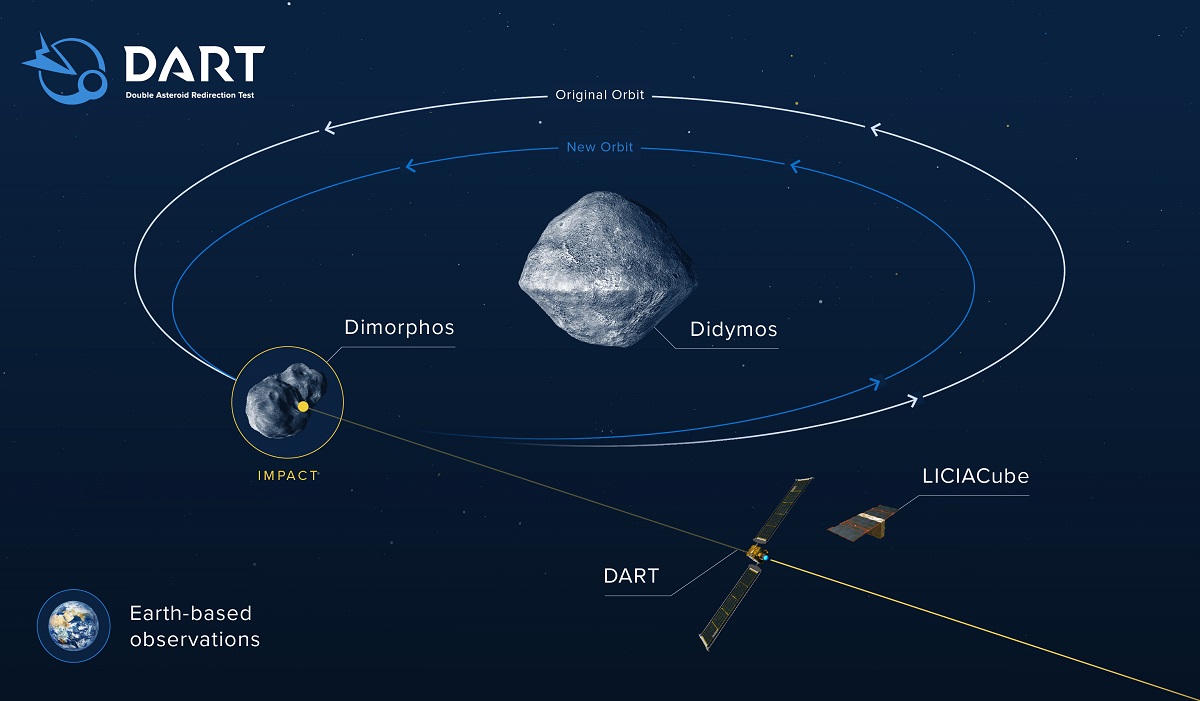
Специалисты НАСА готовят к старту миссию Double Asteroid Redirection Test (DART) -- это первая миссия, цель которой будет изменить траекторию околоземного астероида. Они заправили космический корабль топливом, выполнили многие из заключительных испытаний и проводят репетиции по мере приближения к запланированному запуску DART 23 ноября 2021 года. DART станет первой в мире миссией по испытанию планетарной […]
Сообщение Планетарная защита: названа дата старта миссии DART для отклонения астероида появились сначала на AB-NEWS - Новости науки и техники.
#астрономия #исследованиекосмоса #космонавтика #dart #астероид #lang_ru #ru #abnewsru #abnews #наукаитехника